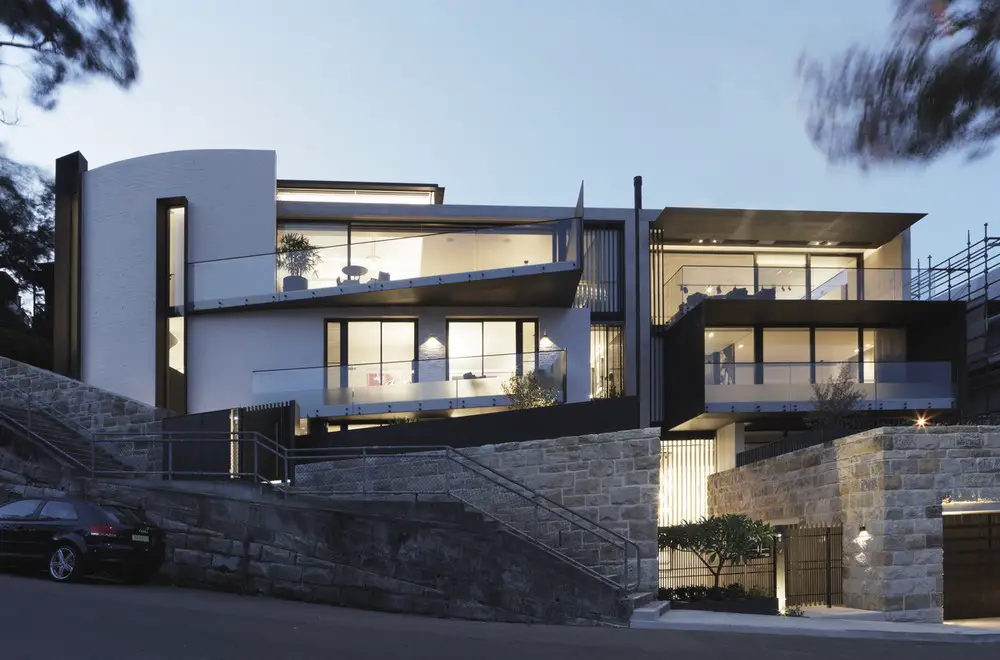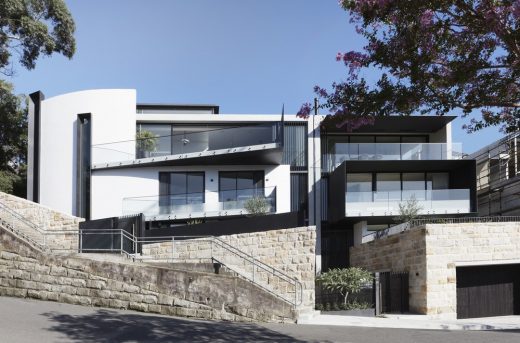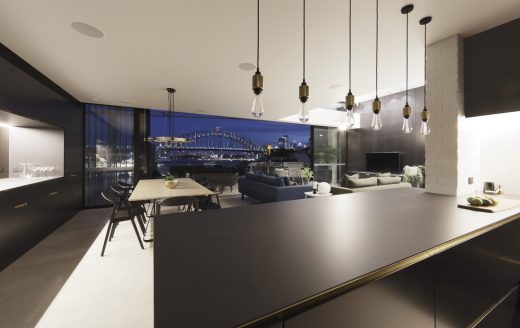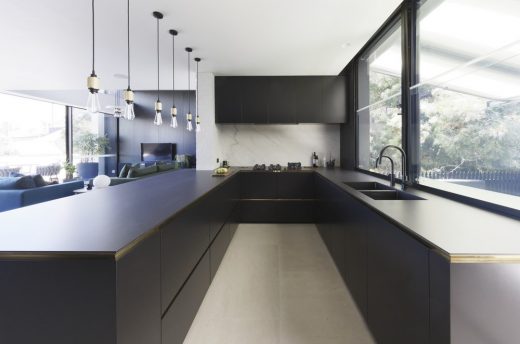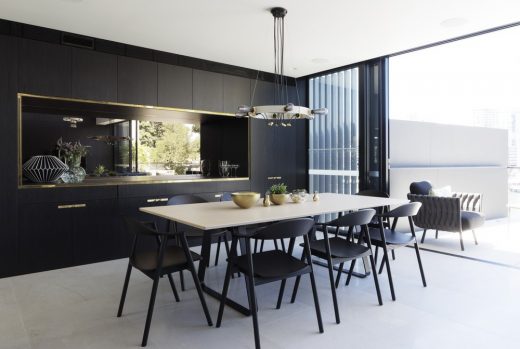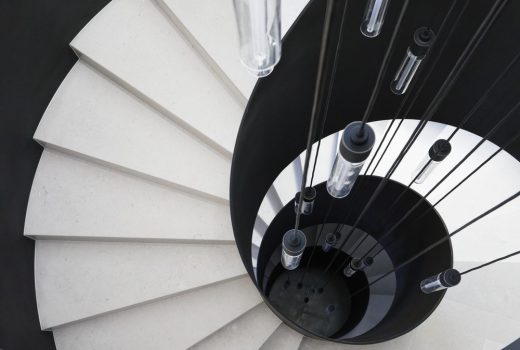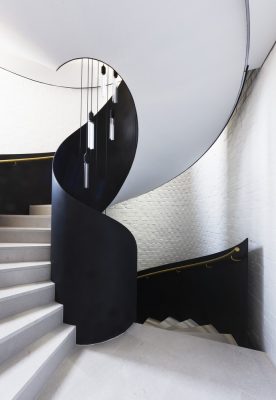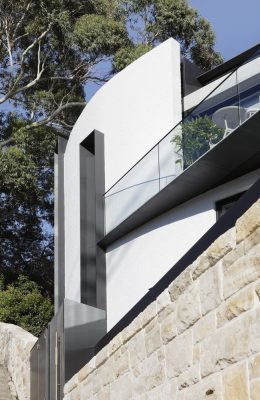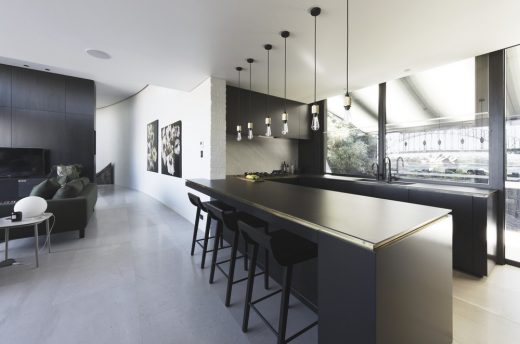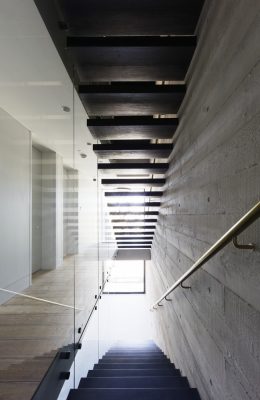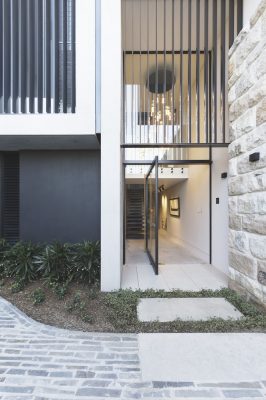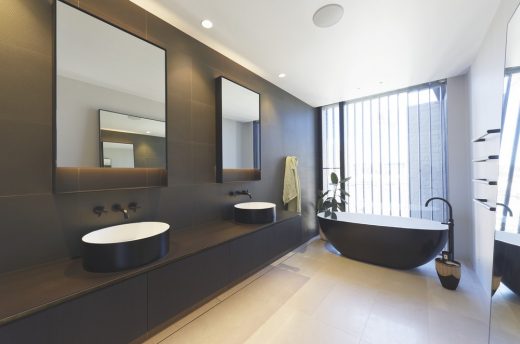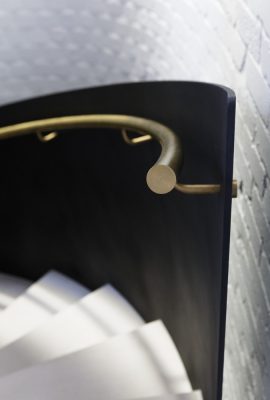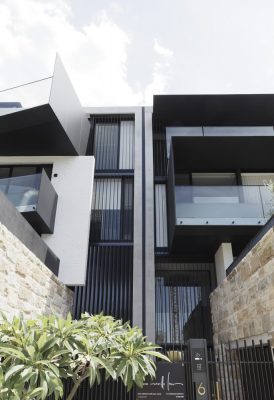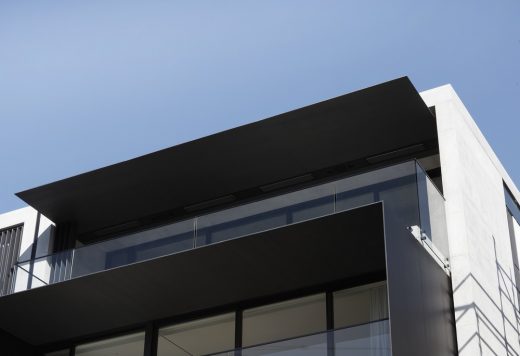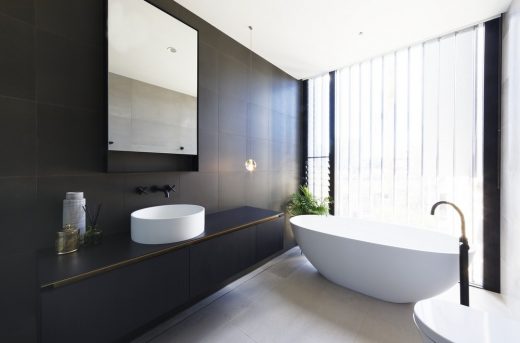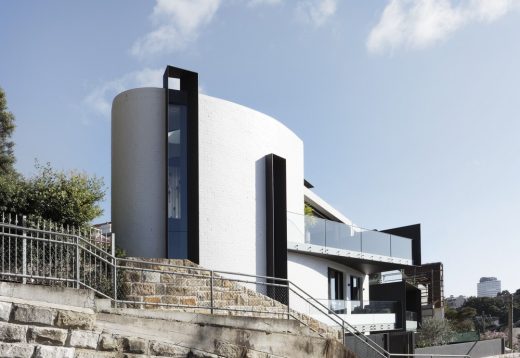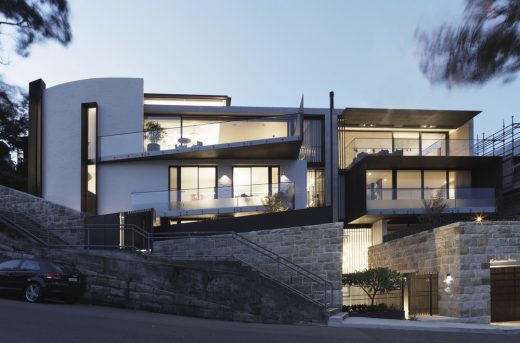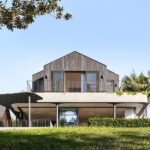Twin Houses, Sydney Homes, NSW Real Estate, Australian Real Estate, Architecture Images
Twin Houses in Sydney
Modern Properties in New South Wales design by Architecture Saville Isaacs, Australia
2 Apr 2019
Twin Houses, New South Wales
Architects: Architecture Saville Isaacs
Location: Sydney, New South Wales, Australia
Twin Houses – siblings, yet each unique.
Responding to the irregular site boundary and contextual differences, the houses take on different yet complementary forms. No.2 presents a street façade of sensually curved brick mass with window penetrations.
No.6 presents a rectilinear off-form concrete frame from which ‘extrudes’ a black steel box – and more expansive glazing. The steel plate surrounds to openings and balcony edges counterbalance the masonry masses, acting as ‘blinkers’ for privacy from the street and focusing views from within.
Both houses sit on the solid base of the heritage stone street wall, relieved by the landscaped entry court.
Light, natural and artificial, sculpts the space accentuating the textural qualities of the materials. Brass is used as a highlight, adding depth and contrast: handrails, shadowlines, door handles, light fittings – polished, brushed, knurled, patinated.
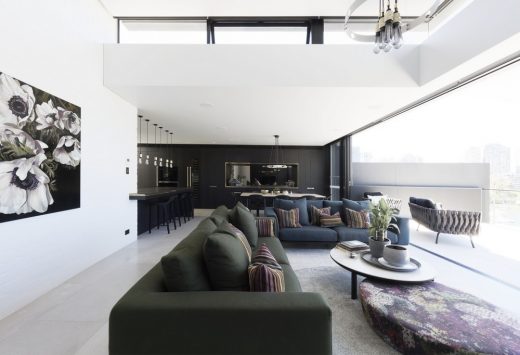
The conceptual approach was to create houses that sit comfortably within the established urban streetscape, provide elements of drama and discovery, and engage with the iconic harbour bridge and opera house views to the front and intimate landscaped gardens to the rear. The sites are small (255sqm and 336sqm), steep and irregular.
Responding to the irregular site boundary and contextual differences, the two houses take on different yet complementary forms, differentiated by mass and material.
Height, bulk and scale are carefully modulated to respond to the adjacent buildings, whilst protecting the iconic views of the properties behind. The houses sit on the stone base of the original heritage street wall, penetrated to allow vehicular access (in the location of the old garage) and to create an entry court (in the location of the old stairway).
The southern dwelling terminates the streetscape, ending in a tightly curved profile (following the unusual site boundary line), which contains a freestanding steel plate and limestone spiral stair. The mass of the heritage street stone wall is relieved by insertion of the recessive landscaped courtyard, articulating the streetscape.
The construction is a language is sandstone base, recycled painted brick and steel plate. The two houses are differentiated by mass and material. No.2 presents a street façade of sensually curved brick mass with window penetrations (responding to the apartment building across the road).
No.6 presents a rectilinear off-form concrete frame from which ‘extrudes’ a black steel box – and more expansive glazing. The raw concrete is continued internally. The steel plate surrounds to openings and balcony edges counterbalance the masonry masses, acting as ‘blinkers’ for privacy from the street below and focusing views from within the houses.
The client brief was for two separate 4 bedroom houses with parking on the tiny sites.
No.6 is for their residence and no.2 for sale. To maximize return on the sale property the clients required the highest standard of quality, finishes, and inclusions.
The houses are excavated into the rock at street level to provide basement parking. Living spaces are placed at the top of the buildings to maximize views, access northern sunlight (through clerestory glazing), and relate back to private gardens at the sunny rear.
The buildings employ thermal mass, cross ventilation and stack effect to minimize energy requirements. Highly efficient land use enhances urban sustainability. Materials are natural, recycled (brick, timber) or recyclable (brick, stone, concrete, steel), whilst composite, highly processed materials are avoided.
The site was extremely constrained, requiring clever planning, extensive excavation, complex construction, all deftly handled to create houses of deceivingly simple clarity.
This challenging project was the outcome of extensive collaboration with the client, specialist consultants, and builder.
Contemporary, modern interiors extrapolate the external materials of off-form concrete, steel plate, painted recycled brick, pale limestone.
Light, natural and artificial, sculpts the space accentuating the textural qualities of the materials. Brass is used as a highlight throughout, adding depth and contrast: on handrails, shadowlines, door handles, light fittings – polished, brushed, knurled, patinated.
Client brief:
2 spacious homes with understated crisp aesthetic. Interiors to follow from architecture. Maximize views. High attention to detail, quality, inclusions, storage, functionality.
Resolution:
Houses layered vertically – parking, entry/guests (or children), master suite living. Each top floor living zone focusses forward to the spectacular iconic views, whilst connecting to intimate, sunny rear gardens.
Each house is unique, responding to context and with individual material palettes.
The curved end one responds to the shape of the site, housing 4 storey recycled brick volume through which spirals a free-standing steel plate and stone stair. Natural light plays across curved brick.
The conceptual approach was to create houses that integrate with the established urban streetscape, provide elements of drama and discovery, and engage with the iconic harbour bridge and opera house views to the front and intimate landscaped gardens to the rear. The sites are small (255sqm and 336sqm), steep and irregular.
The design uses a language of sandstone base, recycled painted brick, and steel plate. The two houses are differentiated by mass and material. No.2 presents a street façade of sensually curved brick mass with window penetrations (responding to the apartment building across the road). No.6 presents a rectilinear off-form concrete frame from which ‘extrudes’ a black steel box – and more expansive glazing.
This challenging project was the outcome of extensive collaboration with the client (who was also the interior designer), specialist consultants and builder, landscape architects, services and structural consultants. The interiors were conceptualized and designed with the interior designer client, through a highly integrated process.
The houses are each highly functional, compact dwellings providing the inhabitants with finely detailed and carefully considered spaces that respond to their context, focusing and framing the iconic views from different perspectives – contributing surprise and delight.
The steel plate surrounds to openings and balcony edges counterbalance the masonry masses, acting as ‘blinkers’ for privacy from the street below and focusing views from within the houses.
The interior design is an extension of architectural language, working with a play of natural and artificial light on different materials and textures – grain, reflectivity, depth, patina are all explored and expressed.
Twin Houses, Sydney – Building Information
Design: Architecture Saville Isaacs
Key products used:
Sub Zero – Fridges, Freezer and Wine Fridges
Wolf – Ovens
B&B Italia
Buster and Punch – Door hardware and feature lighting
Brodware – Tapware
Miele – Dishwashers
Zip Hydotaps
Tongue n Groove Flooring
Winnings – Appliances
Beefeater – BBQs
Aurora – Fireplace
Heatstrip – Outdoor heaters
Clipsal – Satin Zen
Schindler – Lifts
West Elm
Project size: 1100 sqm
Site size: 590 sqm
Completion date: 2019
Building levels: 4
Photographer: Kata Bayer
Twin Houses in Sydney images / information received 020419 from Architecture Saville Isaacs
Location: Sydney, NSW, Australia
Architecture in Sydney
Contemporary New South Wales Buildings
NSW Properties
Architects: anthrosite
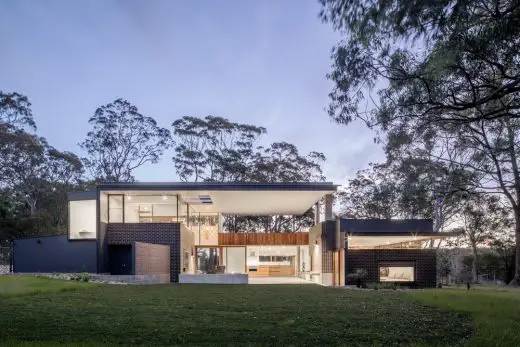
photo : Jon Reid
Contemporary House in Newcastle, NSW
Architects: Tony Owen Partners
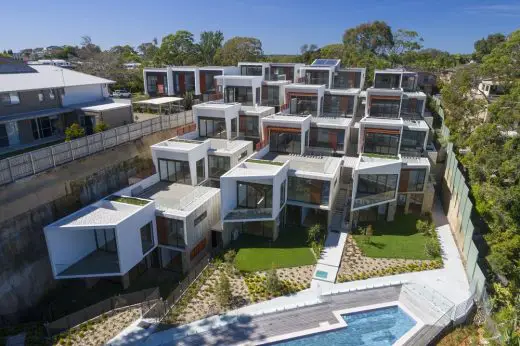
photo : John Gollings
Sovereign Houses in Sylvania
Comments / photos for the Twin Houses in Sydney NSW design by Architecture Saville Isaacs page welcome

